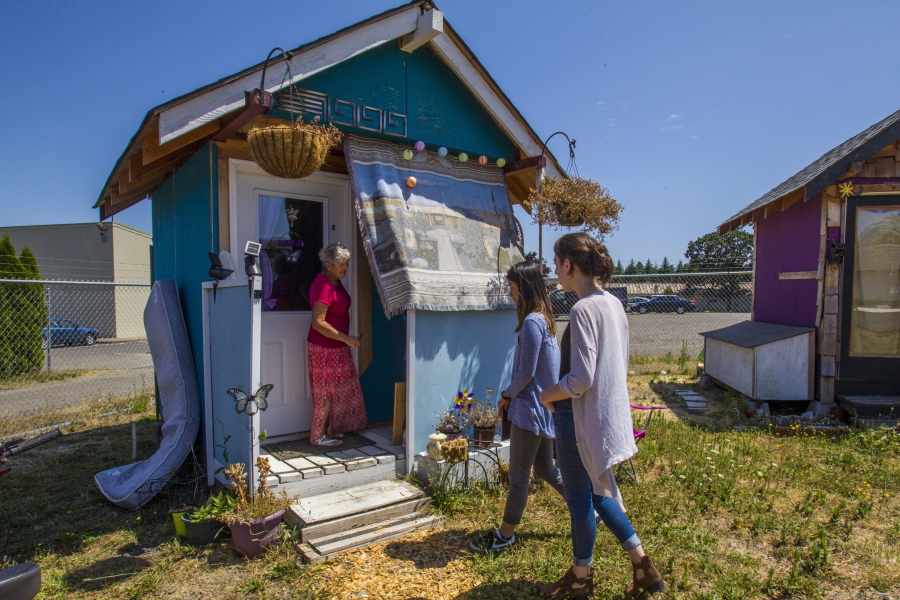EUGENE, Ore. — Alice Gentry hasn’t lived in a house with a bathtub or a kitchen in two years.
“It’s hard to explain if you haven’t had to live it,” Gentry said one day in July. “Being able to take a shower and being able to get out of bed and use the toilet without freezing your buns off; being able to cook; knowing that you’re safe — it’s something people take for granted.”
Gentry, 66, of Eugene has lived in Opportunity Village for almost a year. Opportunity Village, in the North Garfield Street industrial area, is a collection of tiny, movable homes organized by SquareOne Villages, a local nonprofit organization. Gentry lives in a 64-square-foot bungalow.
She shares a separate collective shower and kitchen facility with 37 others. Before, she lived in the back seat of her car.
But thanks to four University of Oregon students, Gentry soon might have a larger home, with its own kitchen, electricity, running water and bathtub.
Doctoral students Lyndsey Deaton and Christina Bollo; graduate student Paige Portwood; and undergraduate Samantha Freson are designing (and hoping to build) a tiny house to add to Emerald Village, a Eugene community of 22 such homes, also coordinated by SquareOne Villages.
The students are finalizing plans for the 180-square-foot building based on what some tiny-home residents say are key amenities. Deaton and her small group of young, aspiring architects also are searching for recycled materials to use and contractors who will volunteer their time.
The project started with Deaton. While pursuing her doctoral degree, she was working for an architectural firm that was enlisted to design a house for Emerald Village. But Deaton said she wasn’t satisfied with the design process.
She said many of the houses designed for Emerald Village were creative and impressive, but did not necessarily serve the needs of the occupants.
“As amazing as (the architectural) firms are that are designing these houses, they’re designing them as an ability to show off what their firm can do,” Deaton said. “Which is totally appropriate, but no one’s actually looking at how to design the most appropriate house for this type of resident.”
What residents want
Deaton said she was more interested in building a house that took into account what low-income residents want. So she decided to build her own tiny house, not funded by the firm. She and Bollo interviewed 14 people in tiny house communities across the country, including Community First in Austin, Texas, and Dignity Village in Gainesville, Fla.
Through her research, she discovered some design elements that were important to people living in tiny house communities but that architects often overlooked.
“Living a transient lifestyle, a bathtub is what dreams are made of,” Deaton said. “There are no bathtubs in a mission (for the homeless). There are no bathtubs in a lot of subsidized housing. And the idea of a stand-up shower was fine, but it had a lot of connotations of being moved in and out of a place, while a bathtub had that connotation of home, of ownership.”
Deaton also found that while residents in tiny house communities valued privacy and the ability to have their own space, it was important to have a community area in their home as well. This led to Deaton and Bollo naming their project the ReachOut House.
“Part of home and having a place of your own is the ability to engage and welcome other people,” Deaton said. “That’s a privilege of someone who has a home; that you can invite other people to it; that you can extend that generosity.”
Price factor
Deaton and Bolo wanted their house to take up as little space as possible, so that it would be more affordable to residents. The ReachOUT house is on the smaller side. Emerald Village houses can range from 150 to 300 square feet and can cost $250 to $350 a month to rent.
Bolo and Deaton designed a house that opens out, with glass French doors that swing open from the kitchen onto a porch. Gentry could fit a long community table into the outside space.
That appealed to Gentry. She was selected in October to be a tenant of Emerald Village. Her Social Security benefits and her minimum-wage, part-time job in crowd management services at events such as the Oregon Country Fair all made her eligible to live in the neighborhood, where tenants’ monthly earnings must be at least $600 but no more than $1,500.
She had the opportunity to look through all 22 of the house designs, and then choose her top three favorites. The ReachOut House, where her monthly rent will be $300, was her first choice.
“I liked the idea of opening it up and having this big, covered porch so you could be outside and you don’t feel so closed in.” she said.
Funding the project
Now comes the hard part for the UO students: raising the money for construction.
Deaton set up a YouCaring crowd-funding campaign to raise money for construction materials and other costs. So far, she’s raised $350 of the needed $10,000. The team hopes to build the house mainly from used materials. Deaton said several builders have donated items such as sinks, plywood and other materials that were left over from home building projects.
“There’s so much construction waste that comes out of developing suburban houses, and it’s just too expensive to haul anywhere, so it almost always goes to the dump,” Deaton said.
SquareOne Villages bought the land for Emerald Village from local businesspeople in May 2015 for $306,000.
Once Deaton and her team finish the house, it becomes the responsibility of SquareOne and the renter.
Deaton said SquareOne uses a “rent-to-own” model, in which residents pay rent to live in the house, but over five years can acquire full ownership that they can sell for $5,000 when they leave.
SquareOne Villages will pour the slab of concrete for the ReachOUT house this month, Deaton said.



